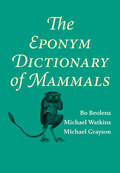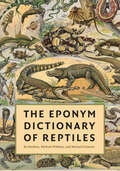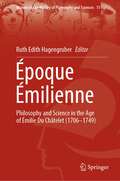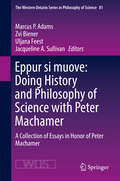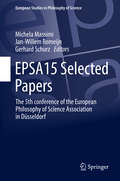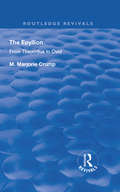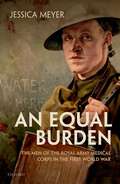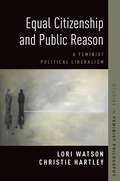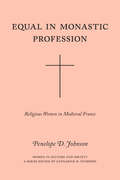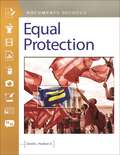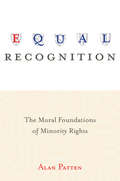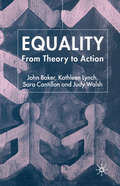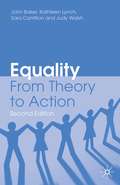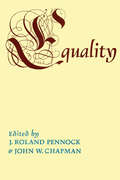- Table View
- List View
The Epochs of Nature
by Georges-Louis LeclercGeorges-Louis Leclerc, le comte de Buffon's The Epochs of Nature, originally published as Les Époques de la Nature in 1778, is one of the first great popular science books, a work of style and insight that was devoured by Catherine the Great of Russia and influenced Humboldt, Darwin, Lyell, Vernadsky, and many other renowned scientists. It is the first geological history of the world, stretching from the Earth’s origins to its foreseen end, and though Buffon was limited by the scientific knowledge of his era—the substance of the Earth was not, as he asserts, dragged out of the sun by a giant comet, nor is the sun’s heat generated by tidal forces—many of his deductions appear today as startling insights. And yet, The Epochs of Nature has never before been available in its entirety in English—until now. In seven epochs, Buffon reveals the main features of an evolving Earth, from its hard rock substrate to the sedimentary layers on top, from the minerals and fossils found within these layers to volcanoes, earthquakes, and rises and falls in sea level—and he even touches on age-old mysteries like why the sun shines. In one of many moments of striking scientific prescience, Buffon details evidence for species extinction a generation before Cuvier’s more famous assertion of the phenomenon. His seventh and final epoch does nothing less than offer the first geological glimpse of the idea that humans are altering the very foundations of the Earth—an idea of remarkable resonance as we debate the designation of another epoch: the Anthropocene. Also featuring Buffon’s extensive “Notes Justificatives,” in which he offers further evidence to support his assertions (and discusses vanished monstrous North American beasts—what we know as mastodons—as well as the potential existence of human giants), plus an enlightening introduction by editor and translator Jan Zalasiewicz and historians of science Sverker Sörlin, Libby Robin, and Jacques Grinevald, this extraordinary new translation revives Buffon’s quite literally groundbreaking work for a new age.
The Eponym Dictionary of Mammals
by Michael Watkins Bo Beolens Michael GraysonJust who was the Przewalski after whom Przewalski's horse was named? Or Husson, the eponym for the rat Hydromys hussoni? Or the Geoffroy whose name is forever linked to Geoffroy's cat? This unique reference provides a brief look at the real lives behind the scientific and vernacular mammal names one encounters in field guides, textbooks, journal articles, and other scholarly works.Arranged to mirror standard dictionaries, the more than 1,300 entries included here explain the origins of over 2,000 mammal species names. Each bio-sketch lists the scientific and common-language names of all species named after the person, outlines the individual's major contributions to mammalogy and other branches of zoology, and includes brief information about his or her mammalian namesake's distribution. The two appendixes list scientific and common names for ease of reference, and, where appropriate, individual entries include mammals commonly—but mistakenly—believed to be named after people.The Eponym Dictionary of Mammals is a highly readable and informative guide to the people whose names are immortalized in mammal nomenclature.
The Eponym Dictionary of Reptiles
by Bo Beolens Michael Watkins Michael GraysonWho was Richard Kemp, after whom the Kemp’s ridley sea turtle is named? Is Wake’s Gecko named after Berkeley’s Marvalee Wake? Or perhaps her husband, David? Why do so many snakes and lizards have Werner in their name? This reference book answers these and thousands of other questions about the origins of the vernacular and scientific names of reptiles across the globe.From Agkistrodon piscivorus conanti, the Florida cottonmouth subspecies named for Roger Conant, to Xantusia, the night lizard genera namesake of John Xantus, this dictionary covers everyone after whom an extant or recently extinct reptile has been named. The entries include a brief bio-sketch, a list of the reptiles that bear the individual’s name, the names of reptiles erroneously thought to be associated with the person, and a summary of major—and sometimes obscure or even incidental—contributions made by the person to herpetology and zoology. An introductory chapter explains how to use the book and describes the process of naming taxa. Easy to use and filled with addictive—and highly useful—information about the people whose names will be carried into the future on the backs of the world’s reptiles, The Eponym Dictionary of Reptiles is a handy and fun book for professional and amateur herpetologists alike.
The Eponym Dictionary of Reptiles
by Michael Watkins Bo Beolens Michael GraysonWho was Richard Kemp, after whom the Kemp’s ridley sea turtle is named? Is Wake’s Gecko named after Berkeley’s Marvalee Wake? Or perhaps her husband, David? Why do so many snakes and lizards have Werner in their name? This reference book answers these and thousands of other questions about the origins of the vernacular and scientific names of reptiles across the globe.From Agkistrodon piscivorus conanti, the Florida cottonmouth subspecies named for Roger Conant, to Xantusia, the night lizard genera namesake of John Xantus, this dictionary covers everyone after whom an extant or recently extinct reptile has been named. The entries include a brief bio-sketch, a list of the reptiles that bear the individual’s name, the names of reptiles erroneously thought to be associated with the person, and a summary of major—and sometimes obscure or even incidental—contributions made by the person to herpetology and zoology. An introductory chapter explains how to use the book and describes the process of naming taxa. Easy to use and filled with addictive—and highly useful—information about the people whose names will be carried into the future on the backs of the world’s reptiles, The Eponym Dictionary of Reptiles is a handy and fun book for professional and amateur herpetologists alike.
Époque Émilienne: Philosophy and Science in the Age of Émilie Du Châtelet (1706-1749) (Women in the History of Philosophy and Sciences #11)
by Ruth Edith HagengruberThe present book contextualizes Du Châtelet’s contribution to the philosophy of her time. The editor offers this tribute to an Époque Émiliennee as a collection of innovative papers on Emilie Du Châtelet’s powerful philosophy and legacy.Du Châtelet was an outstanding figure in the era she lived in. Her work and achievements were unique, though not an exception in the 18th century, which did not lack outstanding women. Her personal intellectual education, her scholarly network and her mental acumen were celebrated in her time, perceiving her to have “multiplied nine figures by nine figures in her head”. She was able to gain access to institutions which were normally denied to women. To call an epoch an Époque Émilienne may be seen as daring and audacious, but it will not be the last time if we continue to bring women philosophers back into the memory of the history of philosophy. The contributors paid attention to the philosophical state of the art, which forms the background to Du Châtelet’s philosophy. They follow the transformation of philosophical concepts under her pen and retrace the impact of her ideas. The book is of interest to scholars working in the history of philosophy as well as in gender studies. It is of special interest for scholars working on the 18th century, Kant, Leibniz, Wolff, Newton and the European Enlightenment.
Eppur si muove: A Collection of Essays in Honor of Peter Machamer (The Western Ontario Series in Philosophy of Science #81)
by Marcus P. Adams Zvi Biener Uljana Feest Jacqueline A. SullivanThis volume is a collection of original essays focusing on a wide range of topics in the History and Philosophy of Science. It is a festschrift for Peter Machamer, which includes contributions from scholars who, at one time or another, were his students. The essays bring together analyses of issues and debates spanning from early modern science and philosophy through the 21st century. Machamer’s influence is reflected in the volume’s broad range of topics. These include: underdetermination, scientific practice, scientific models, mechanistic explanation in contemporary and historical science, values in science, the relationship between philosophy and psychology, experimentation, supervenience and reductionism.
EPSA15 Selected Papers: The 5th conference of the European Philosophy of Science Association in Düsseldorf (European Studies in Philosophy of Science #5)
by Michela Massimi Jan-Willem Romeijn Gerhard SchurzThis edited collection showcases some of the best recent research in the philosophy of science. It comprises of thematically arranged papers presented at the 5th conference of the European Philosophy of Science Association (EPSA15), covering a broad variety of topics within general philosophy of science, and philosophical issues pertaining to specific sciences. The collection will appeal to researchers with an interest in the philosophical underpinnings of their own discipline, and to philosophers who wish to study the latest work on the themes discussed.
The Epyllion: From Theocritus to Ovid (Routledge Revivals)
by M. Marjorie CrumpPublished in 1931: The Epyllion From Theocritus to Ovid discusses Greek Epics along with extracts of Poems.
The Epyllion: From Theocritus to Ovid (Routledge Revivals)
by M. Marjorie CrumpPublished in 1931: The Epyllion From Theocritus to Ovid discusses Greek Epics along with extracts of Poems.
An Equal Burden: The Men of the Royal Army Medical Corps in the First World War
by Jessica MeyerThis is an open access title available under the terms of a CC BY-NC-ND 4.0 International licence. It is free to read at Oxford Scholarship Online and offered as a free PDF download from OUP and selected open access locations. An Equal Burden is the first scholarly study of the Army Medical Services in the First World War to focus on the roles and experiences of the men of the Royal Army Medical Corps (RAMC). Though they were not professional medical caregivers, they were called upon to provide urgent medical care and, as non-combatants, were forbidden from carrying weapons. Their role in the war effort was quite unique and warranting of further study. Structured both chronologically and thematically, An Equal Burden examines the work that RAMC rankers undertook and its importance to the running of the chain of medical evacuation. It additionally explores the gendered status of these men within the medical, military, and cultural hierarchies of a society engaged in total war. Through close readings of official documents, personal papers, and cultural representations, Meyer argues that the ranks of the RAMC formed a space in which non-commissioned servicemen, through their many roles, defined and redefined medical caregiving as men's work in wartime.
An Equal Burden: The Men of the Royal Army Medical Corps in the First World War
by Jessica MeyerThis is an open access title available under the terms of a CC BY-NC-ND 4.0 International licence. It is free to read at Oxford Scholarship Online and offered as a free PDF download from OUP and selected open access locations. An Equal Burden is the first scholarly study of the Army Medical Services in the First World War to focus on the roles and experiences of the men of the Royal Army Medical Corps (RAMC). Though they were not professional medical caregivers, they were called upon to provide urgent medical care and, as non-combatants, were forbidden from carrying weapons. Their role in the war effort was quite unique and warranting of further study. Structured both chronologically and thematically, An Equal Burden examines the work that RAMC rankers undertook and its importance to the running of the chain of medical evacuation. It additionally explores the gendered status of these men within the medical, military, and cultural hierarchies of a society engaged in total war. Through close readings of official documents, personal papers, and cultural representations, Meyer argues that the ranks of the RAMC formed a space in which non-commissioned servicemen, through their many roles, defined and redefined medical caregiving as men's work in wartime.
Equal Citizenship and Public Reason: A Feminist Political Liberalism (Studies in Feminist Philosophy)
by Christie Hartley Lori WatsonThis book is a defense of political liberalism as a feminist liberalism. The first half of the book develops and defends a novel interpretation of political liberalism. It is argued that political liberals should accept a restrictive account of public reason and that political liberals' account of public justification is superior to the leading alternative, the convergence account of public justification. The view is defended from the charge that such a restrictive account of public reason will unduly threaten or undermine the integrity of some religiously oriented citizens and an account of when political liberals can recognize exemptions, including religious exemptions, from generally applicable laws is offered. In the second half of the book, it is argued that political liberalism's core commitments restrict all reasonable conceptions of justice to those that secure genuine, substantive equality for women and other marginalized groups. Here it is demonstrated how public reason arguments can be used to support law and policy needed to address historical sites of women's subordination in order to advance equality; prostitution, the gendered division of labor and marriage, in particular, are considered.
Equal Citizenship and Public Reason: A Feminist Political Liberalism (Studies in Feminist Philosophy)
by Lori Watson Christie HartleyThis book is a defense of political liberalism as a feminist liberalism. The first half of the book develops and defends a novel interpretation of political liberalism. It is argued that political liberals should accept a restrictive account of public reason and that political liberals' account of public justification is superior to the leading alternative, the convergence account of public justification. The view is defended from the charge that such a restrictive account of public reason will unduly threaten or undermine the integrity of some religiously oriented citizens and an account of when political liberals can recognize exemptions, including religious exemptions, from generally applicable laws is offered. In the second half of the book, it is argued that political liberalism's core commitments restrict all reasonable conceptions of justice to those that secure genuine, substantive equality for women and other marginalized groups. Here it is demonstrated how public reason arguments can be used to support law and policy needed to address historical sites of women's subordination in order to advance equality; prostitution, the gendered division of labor and marriage, in particular, are considered.
Equal Citizenship, Civil Rights, and the Constitution: The Original Sense of the Privileges or Immunities Clause (Routledge Research in Constitutional Law)
by Christopher GreenThe Privileges or Immunities Clause of the Fourteenth Amendment is arguably the most historically important clause of the most significant part of the US Constitution. Designed to be a central guarantor of civil rights and civil liberties following Reconstruction, this clause could have been at the center of most of the country's constitutional controversies, not only during Reconstruction, but in the modern period as well; yet for a variety of historical reasons, including precedent-setting narrow interpretations, the Privileges or Immunities Clause has been cast aside by the Supreme Court. This book investigates the Clause in a textualist-originalist manner, an approach increasingly popular among both academics and judges, to examine the meanings actually expressed by the text in its original context. Arguing for a revival of the Privileges or Immunities Clause, author Christopher Green lays the groundwork for assessing the originalist credentials of such areas of law as school segregation, state action, sex discrimination, incorporation of the Bill of Rights against states, the relationship between tradition and policy analysis in assessing fundamental rights, and the Fourteenth Amendment rights of corporations and aliens. Thoroughly argued and historically well-researched, this book demonstrates that the Privileges or Immunities Clause protects liberty and equality, and it will be of interest to legal academics, American legal historians, and anyone interested in American constitutional history.
Equal Citizenship, Civil Rights, and the Constitution: The Original Sense of the Privileges or Immunities Clause (Routledge Research in Constitutional Law)
by Christopher GreenThe Privileges or Immunities Clause of the Fourteenth Amendment is arguably the most historically important clause of the most significant part of the US Constitution. Designed to be a central guarantor of civil rights and civil liberties following Reconstruction, this clause could have been at the center of most of the country's constitutional controversies, not only during Reconstruction, but in the modern period as well; yet for a variety of historical reasons, including precedent-setting narrow interpretations, the Privileges or Immunities Clause has been cast aside by the Supreme Court. This book investigates the Clause in a textualist-originalist manner, an approach increasingly popular among both academics and judges, to examine the meanings actually expressed by the text in its original context. Arguing for a revival of the Privileges or Immunities Clause, author Christopher Green lays the groundwork for assessing the originalist credentials of such areas of law as school segregation, state action, sex discrimination, incorporation of the Bill of Rights against states, the relationship between tradition and policy analysis in assessing fundamental rights, and the Fourteenth Amendment rights of corporations and aliens. Thoroughly argued and historically well-researched, this book demonstrates that the Privileges or Immunities Clause protects liberty and equality, and it will be of interest to legal academics, American legal historians, and anyone interested in American constitutional history.
Equal in Monastic Profession: Religious Women in Medieval France (Women in Culture and Society)
by Penelope D. JohnsonIn this study of the manner in which medieval nuns lived, Penelope Johnson challenges facile stereotypes of nuns living passively under monastic rule, finding instead that collectively they were empowered by their communal privileges and status to think and act without many of the subordinate attitudes of secular women. In the words of one abbess comparing nuns with monks, they were "different as to their sex but equal in their monastic profession." Johnson researched more than two dozen nunneries in northern France from the eleventh century through the thirteenth century, balancing a qualitative reading of medieval monastic documents with a quantitative analysis of a lengthy thirteenth-century visitation record which allows an important comparison of nuns and monks. A fascinating look at the world of medieval spirituality, this work enriches our understanding of women's role in premodern Europe and in church history.
Equal in Monastic Profession: Religious Women in Medieval France (Women in Culture and Society)
by Penelope D. JohnsonIn this study of the manner in which medieval nuns lived, Penelope Johnson challenges facile stereotypes of nuns living passively under monastic rule, finding instead that collectively they were empowered by their communal privileges and status to think and act without many of the subordinate attitudes of secular women. In the words of one abbess comparing nuns with monks, they were "different as to their sex but equal in their monastic profession." Johnson researched more than two dozen nunneries in northern France from the eleventh century through the thirteenth century, balancing a qualitative reading of medieval monastic documents with a quantitative analysis of a lengthy thirteenth-century visitation record which allows an important comparison of nuns and monks. A fascinating look at the world of medieval spirituality, this work enriches our understanding of women's role in premodern Europe and in church history.
Equal Justice in the Balance: America's Legal Responses to the Emerging Terrorist Threat
by Raneta Lawson Mack Michael J. Kelly"We are in difficult times for the protection of our liberties. Nonetheless, citizens are showing an increased willingness to resist the erosion of the U.S. Constitution. . . . Lawson Mack and Kelly stress the importance of not giving up these fundamental rights and conclude with a message of optimism, noting an increased backlash against the administration's more draconian measures. Although the landscape is still quite bleak, change is in the air." -Michael Ratner, President, Center for Constitutional Rights, from the foreword "A compelling and sophisticated critique of the U.S. government's post-9/11 actions. Mack and Kelly set the stage with the historical perspective on America's response to terrorism and the assessment of terrorist threats, before launching into a comprehensive analysis of the USA Patriot Act. Their hard-hitting approach and easy-to-read style makes for a fascinating treatment of the government's legislative and executive response to the attacks." -Michael P. Scharf, Case Western Reserve University School of Law With its sweeping critique of the USA Patriot Act and the Bush administration's maneuvers in pursuit of terrorists, Equal Justice in the Balance is a sobering and exacting look at American legal responses to terrorism, both before and after 9/11. The authors detail wide-ranging and persuasive evidence that American antiterrorism legislation has led to serious infringements of our civil rights. They show us how deviations from our fundamental principles of fairness and justice in times of heightened national anxiety-whether the Red Scare, World War II, or the War on Terrorism-have resulted in overreaction and excess, later requiring apologies and reparations to those victimized by a paranoia-driven justice system. While terrorist attacks-especially on a large scale and on American soil-damage our national pride and sense of security, the authors offer powerful arguments for why we must allow our judicial infrastructure, imperfect as it is, to respond without undue interference from the politics of anger and vengeance.
Equal Protection: Documents Decoded (Documents Decoded)
by David L. Jr.This book uses primary sources to closely examine the Equal Protection Clause of the Fourteenth Amendment and to show how legal interpretations of it have had a profound impact on American life as we know it.The Fourteenth Amendment addresses many aspects of American citizenship, including the rights of citizens. The most commonly used—and frequently litigated—phrase in the amendment is "equal protection of the laws." This phrase has figured prominently in a plethora of landmark cases in U.S. history dealing with a variety of issues, including Brown v. Board of Education (racial discrimination), Roe v. Wade (reproductive rights), Bush v. Gore (election recounts), Reed v. Reed (gender discrimination), University of California v. Bakke (racial quotas in college admissions), and Obergefell v. Hodges (gay marriage). This book closely examines the history and development of the Equal Protection Clause and details the many ways in which it has shaped U.S. history. Selections show how the equal protection clause came into being in the post-Civil War era; feature seminal Supreme Court decisions on the nature and extent of applications of the equal protection clause in American life and law through the years; and include documents that consider the impact that the equal protection clause has had and may have on American society in the 21st century.
Equal Protection: Documents Decoded (Documents Decoded)
by David L. Jr.This book uses primary sources to closely examine the Equal Protection Clause of the Fourteenth Amendment and to show how legal interpretations of it have had a profound impact on American life as we know it.The Fourteenth Amendment addresses many aspects of American citizenship, including the rights of citizens. The most commonly used—and frequently litigated—phrase in the amendment is "equal protection of the laws." This phrase has figured prominently in a plethora of landmark cases in U.S. history dealing with a variety of issues, including Brown v. Board of Education (racial discrimination), Roe v. Wade (reproductive rights), Bush v. Gore (election recounts), Reed v. Reed (gender discrimination), University of California v. Bakke (racial quotas in college admissions), and Obergefell v. Hodges (gay marriage). This book closely examines the history and development of the Equal Protection Clause and details the many ways in which it has shaped U.S. history. Selections show how the equal protection clause came into being in the post-Civil War era; feature seminal Supreme Court decisions on the nature and extent of applications of the equal protection clause in American life and law through the years; and include documents that consider the impact that the equal protection clause has had and may have on American society in the 21st century.
Equal Recognition: The Moral Foundations of Minority Rights
by Alan PattenConflicting claims about culture are a familiar refrain of political life in the contemporary world. On one side, majorities seek to fashion the state in their own image, while on the other, cultural minorities press for greater recognition and accommodation. Theories of liberal democracy are at odds about the merits of these competing claims. Multicultural liberals hold that particular minority rights are a requirement of justice conceived of in a broadly liberal fashion. Critics, in turn, have questioned the motivations, coherence, and normative validity of such defenses of multiculturalism. In Equal Recognition, Alan Patten reasserts the case in favor of liberal multiculturalism by developing a new ethical defense of minority rights.Patten seeks to restate the case for liberal multiculturalism in a form that is responsive to the major concerns of critics. He describes a new, nonessentialist account of culture, and he rehabilitates and reconceptualizes the idea of liberal neutrality and uses this idea to develop a distinctive normative argument for minority rights. The book elaborates and applies its core theoretical framework by exploring several important contexts in which minority rights have been considered, including debates about language rights, secession, and immigrant integration.Demonstrating that traditional, nonmulticultural versions of liberalism are unsatisfactory, Equal Recognition will engage readers interested in connections among liberal democracy, nationalism, and current multicultural issues.
Equal Recognition: The Moral Foundations of Minority Rights
by Alan PattenConflicting claims about culture are a familiar refrain of political life in the contemporary world. On one side, majorities seek to fashion the state in their own image, while on the other, cultural minorities press for greater recognition and accommodation. Theories of liberal democracy are at odds about the merits of these competing claims. Multicultural liberals hold that particular minority rights are a requirement of justice conceived of in a broadly liberal fashion. Critics, in turn, have questioned the motivations, coherence, and normative validity of such defenses of multiculturalism. In Equal Recognition, Alan Patten reasserts the case in favor of liberal multiculturalism by developing a new ethical defense of minority rights.Patten seeks to restate the case for liberal multiculturalism in a form that is responsive to the major concerns of critics. He describes a new, nonessentialist account of culture, and he rehabilitates and reconceptualizes the idea of liberal neutrality and uses this idea to develop a distinctive normative argument for minority rights. The book elaborates and applies its core theoretical framework by exploring several important contexts in which minority rights have been considered, including debates about language rights, secession, and immigrant integration.Demonstrating that traditional, nonmulticultural versions of liberalism are unsatisfactory, Equal Recognition will engage readers interested in connections among liberal democracy, nationalism, and current multicultural issues.
Equality: From Theory to Action
by J. Baker K. Lynch S. Cantillon J. WalshHow can egalitarian ideals be put into action? This ground-breaking book sets out a new interdisciplinary model for equality studies. Integrating normative questions about the ideal of equality with empirical issues about the nature of inequality, it applies a new framework to a wide range of contemporary inequalities. Proposing far-reaching changes in the economy, politics, law, education and research practices, it sets out innovative political strategies for achieving those aims. It is an invaluable resource for both academics and activists.
Equality: From Theory to Action
by John Baker K. Lynch Sara Cantillon Judy WalshHow can egalitarian ideals be put into action? This ground-breaking book sets out a new interdisciplinary model for equality studies. Integrating normative questions about the ideal of equality with empirical issues about the nature of inequality, it applies a new framework to a wide range of contemporary inequalities. Proposing far-reaching changes in the economy, politics, law, education and research practices, it sets out innovative political strategies for achieving those aims. It is an invaluable resource for both academics and activists.
Equality
by John W. ChapmanEquality--the battle cry of the French Revolution--has come to be accepted as everyone's birthright today. But what is equality? Is it a chimera in a world manifestly still abounding in inequality among individuals, nations, and races? To this eternally fascinating subject, eighteen outstanding political scientists, jurists, and philosophers address themselves with vigor and profundity in this important and illuminating work.Part I deals with fundamental concepts of equality. The first paper in this section explores such issues as the meaning, the justification, and the dialectics of equality, wherein some of its manifestations are confronted and limited by others. While the second paper criticizes the first essay and examines the legal aspects of equality. Another paper pursues the notion of proportionate equality to what he views as its ultimate reality: that of a purely formal logical concept, while another argues that "egalitarianism" has reference to human interests, which in fact give it content. Another viewpoint considers how far different kinds of equality are compatible with one another and with the enlargement of freedom and fraternity in industrial society. The final paper in this section talks widely over basic issues raised by the various interpretations of equality.Part II deals with sources of beliefs about equality. The papers in this section consider the implications for egalitarianism of Christianity, Judaism, and Hinduism. The final essay in this section surveys the treatment of and implications for egalitarianism in the thinking of the existentialists.Part III is concerned with the political and legal applications of equality. One of the papers suggests that Tocqueville's "providential fact of the gradual development of the principle of equality" might possibly be on the eve of a reversal, and concludes with justification of political equality. Another attacks the notion of equality of opportunity, contending that it is not an authentic expression of the democratic ideal and temper, which requires instead an "affirmation of being and belonging." Following that the highly topical problem of equality in the administration of justice is discussed as well as, the deals with many subtle distinctions involved in the application of the idea of equality to the rule of law. The book concludes with the topic of treatments of the problem of equality in the realm of international politics and organization.

